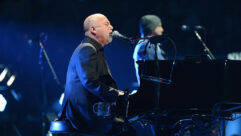
From the Fire
Oct 15, 2013 3:50 PM,
By Cynthia Wisehart
Restoration AV

After an extensive fire forced a major cleanup and restoration to the 18th century St. Ursen Cathedral, the already long reverb increased—just one factor that helped define the electroacoustic renovation.
Fire is one of the most devastating events that can befall a congregation. People often feel deeply connected to the look and sound of their house of worship. The voice of the community inevitably takes on a different character as it fills a church that has been restored from fire.
This can be a good thing. While fires bring disruption and sometimes tragedy, they also bring opportunity, especially for churches with aging audio systems and acoustic properties that may be centuries old.
In January of 2011, in the Baroque town of Solothurn, Switzerland, a lone arsonist poured two cans of gasoline in the sanctuary of the St. Ursen Cathedral and ignited them. The fire massively damaged the 18th century cathedral, destroying the altar and parts of the nave and sanctuary, covering the alabaster walls, soaring ceilings, and world-renowned organ with a sticky film of soot and oil.
The timing was terrible (and perhaps intentional). St. Ursen was scheduled to host a formal consecration ceremony for the controversial new Basel Diocesan Bishop in five days. Instead, the cathedral closed to began years of renovation.
When people enter St. Ursen Cathedral today, the first thing they remark upon is the gleaming white and gilded surfaces. The painstaking cleanup (by Flury und Rudolf Architekten AG) removed the soot and oil, as well as centuries of dust—dust that had functioned as acoustical dampening in the cavernous space. “It was slight but measurable,” says Michael Chollett of Walters-Storyk Design Group. “The church measured a very long reverb in the mid-frequencies to begin with (RT60 of more than 6 seconds at 500Hz), which became worse with the cleaning.”

The diocese had already been planning a major overhaul for the cathedral with a five-year window. Design was underway at the time of the fire for things like networking, security cameras, and lighting. “The fire triggered the work to be done much earlier than anticipated,” Chollet says, “and since much had already been discussed and prepared, it was greatly accelerated—five times quicker.”
The restoration encompassed every aspect of the building: surfaces, art, lighting, HVAC, electrical, electroacoustic, even a touch control system for the 18th century bells. The central challenge of the AV design was the size of the room, especially the very large distances from the altar to the rear of the church and from the main organ and choir to the auxiliary organ. How to achieve intelligibility and sync? The “very live” room seats about 1,000 people and had to be tamed without affecting the distinctive aesthetics or changing any materialization. Further, the room presented several acoustically shadowed areas, where approximately 1/3 of congregants had been missing out on the worship experience.
The design incorporated a savvy mix of cutting-edge and traditional tools: next-generation steerable line array technology, modeling software, and good old analog signal.
By running modeling scenarios with Swedish software CATT-Acoustic (similar to EASE), Chollet says they selected a line array over a distributed configuration. “We settled on the latest generation of steerable line array,” Chollet says, a total of eight CVS Clearvoice Evolutone (2x 3000, 2x 2000 for the main playback and delays, and 6×1000 for the shadowed areas). He says the speakers have a very long-range throw, highly sophisticated steering algorithms and high speech intelligibility. “With steerable arrays, we came from broadband speakers to speakers that have higher channel count—16 or 24—and two-way high- and low-frequency drivers. These advancements make the steering more precise and give better acoustical result with music. When you’re play music you’re happy to have the latest generation of these speakers.”
The DSP is not so impressive, he says—because it didn’t have to be. “It’s not the main issue,” Chollet says. “So the decision was to go for compromise on the DSP and have the budget for the speakers.
From the Fire
Oct 15, 2013 3:50 PM,
By Cynthia Wisehart
Restoration AV

All the DSP is concentrated at the front of the church via a simply configured BBS Soundweb BLU-link backbone driven by a Crestron touchpanel. “There’s actually an awkward path from the front to the back of the church, and it’s a very long distance, which ruled out copper,” Chollet says. “We decided to have the distributed system up front and run traditional analog across the remaining 600ft.”
As it turned out, analog served the church’s purposes in more ways than one and for video as well as audio. One key element of the worship program involves organ duets for two organs that are positioned at a great distance from either other. “As far apart as you can imagine,” Chollet says with a laugh. The organists are on a DSP intercom/headphone (which they can run independently from the full network for practice sessions). “This made us think about latency more than we normally would have,” Cholett says. He says that the small network delivers very low latency, and with the organ and feedback monitor wedges all analog to the network, the organists have no problems syncing.
The same kind of time-critical monitoring system was necessary for another of the worship configurations in which the choir and choirmaster are at the front of the church—600ft. from the main organ. Designers specified a video system to allow the organist to see the conductor; digital HD/SDI cameras with good lenses delivered the resolution, but with “very visible delay.” So once again analog was right for the application. “It was not very satisfying from the technical view—there is a big visual difference between analog video and full HD. But the organist doesn’t need to see a lot of detail; she needs to see the conductor’s hand move. They know each other well and she can read him without seeing detail—it was more important that there was no delay.”
When it came to installation (in collaboration with the architects and installer Stefan Gfeller of Gfeller Licht- und Tontechink AG), the driving force was the fourth member of the team: the cathedral’s historical committee. “Every choice we make on something that is visible needs to go through this committee that is going to have a completely different set of criteria,” Cholett recalls. “They don’t care about speech intelligibility; they care about the visual impact and the location of columns.”
For instance, he says, the WSDG team had been considering a freestanding solution, but in discussions with the committee, it was ruled out because the speakers would have had to be too far out of optimal left/right for aesthetic reasons. “Also,” he says, “the church has rather massive pillars that produce large areas that have direct acoustic energy—1/3 of the seats are in the shadow and have no direct acoustic access to the main speaker. We had to add in additional line arrays to each of the columns to blend into these areas.” However, those speakers then required a custom mount, fabricated with the integrator, to deliver the right angle without visible metalwork, something that’s fairly typical in these types of installations.
The most dramatic intersection of aesthetics and technology occurred around St. Ursen’s High Altar. Since this was where the fire started, the original altar was destroyed—both physically and spiritually. It was not enough to replace the structure of the altar; it needed to be brought to life with an entirely new energy. The commission invited a team to design the new altar; the spectacular winning design was a monolith comprised of 11 kinds of marble forged into a single 7-ton block. “It is truly a work of art,” Chollet says. But it is also a vast, acoustically uncontrolled surface for the microphones. “The first problem was actually cabling. We found a 4in. recess at the bottom so we could get the cables in there.” But the larger problem was intelligibility. The microphones do not have a fixed position and there can be up to 2ft. between the speaker and the microphone—in an application with high gain requirement. Reluctantly WSDG turned to feedback suppression. “We had hoped to get away without it, it really is a last resort as a designer, but the Bosch unit that we use does frequency shifting instead of notching, so it’s a good solution.” Chollet says they also got a good surprise from the new wireless Shure microphone they specified. “It just came out at exactly the right time, and it’s the most natural sounding mic,” Chollet says. “It’s now my go-to choice. Usually you have more control issues with the headworn and the lapel mics than the wired mics—here it was the other way around. We had those control issues with altar mics, but when we mixed the room, we had no problems with the wireless mics.”
The final noteworthy aesthetic challenge was where to satisfy the church’s long-held desire for an induction loop. It wasn’t practical to use the cable duct—which was 20 meters overhead. “We found a solution to put individual induction loops around the main seating areas,” Chollet says. “The wood benches sit atop a little platform and we decided to lift that platform and put the induction loop underneath—we got 90 percent of the area covered that way with four loops. It was an outside-the-box idea, kind of a nutty idea, but [integrator] Stefan Gfeller pulled it off.”
It was just one of the many small acts of creation that grew out of one act of destruction that ultimately strengthened the voice of St. Ursen.
From the Fire
Oct 15, 2013 3:50 PM,
By Cynthia Wisehart
Restoration AV

DIGITAL FIRE
For another 1,000-seat church—the First Baptist Church of Elkhart, Ind.—fire was a “game changer,” according to Robbie Starkey of CSD Group, Fort Wayne, Ind., who designed and installed the new audio, video, and lighting systems. “The biggest priority became upgrading their systems to modern digital technology from analog,” Starkey says.
The upgrade had not been on the drawing board; like many churches, First Baptist had been putting Band-Aids on its analog system for over a decade. When fire and water destroyed all the systems four days before the church’s traditional Halloween event, it became an opportunity, the chance to support their mix of traditional and contemporary services with modern line arrays, digital consoles, and HD video. The new audio system includes a QSC KLA active line array loudspeaker system comprising 13 KLA12 12in., two-way elements in an LCR configuration plus a pair of KLA181 18in. subwoofers, together with four KW181 self-powered 18in. subs and a pair of K8 active front fills on the floor.
The main KLA12 arrays are configured with four boxes at left and right plus five in a center hang. “The extra top box is shooting to the back balcony,” explains Starkey, who got his first hands-on experience with the QSC rigging system at the church. “I was a little leery at first about doing the installation myself. But we were so stressed with work that, even though that’s not part of my job description, I went and hung the system and tuned it myself. You can fly five of those boxes instantly because of the ease of the QSC rigging hardware.”
The compact KLA12 arrays fit the church leaders’ desired aesthetic. “They didn’t want to have too many boxes hanging down really far from the ceiling, so the box count was relevant,” Starkey explains.
CSD Group also designed new digital mixing system and wireless IEM for the praise band around an Allen & Heath iLive desk and a Roland switcher. The renovated sanctuary also now includes a complete two screen Panasonic HD video IMAG system as well as intelligent theatrical lighting.
In May, the church reopened to a standing-room-only crowd of more than 1,000 worshipers.










